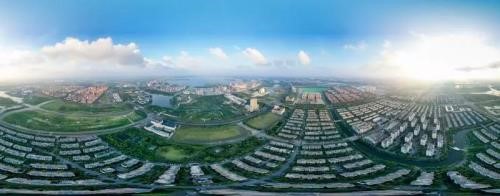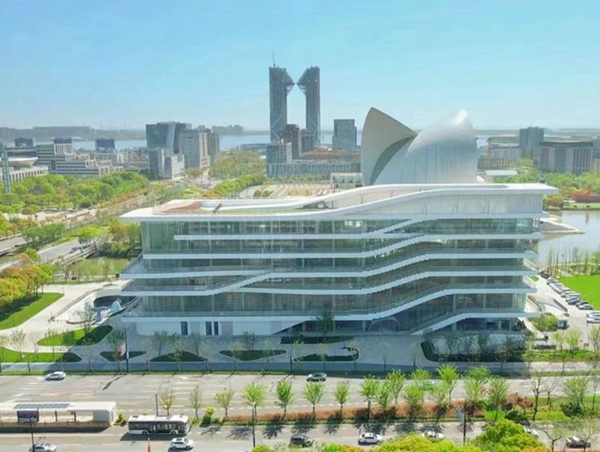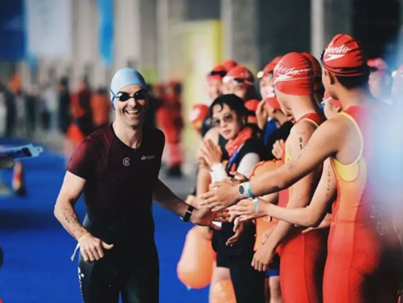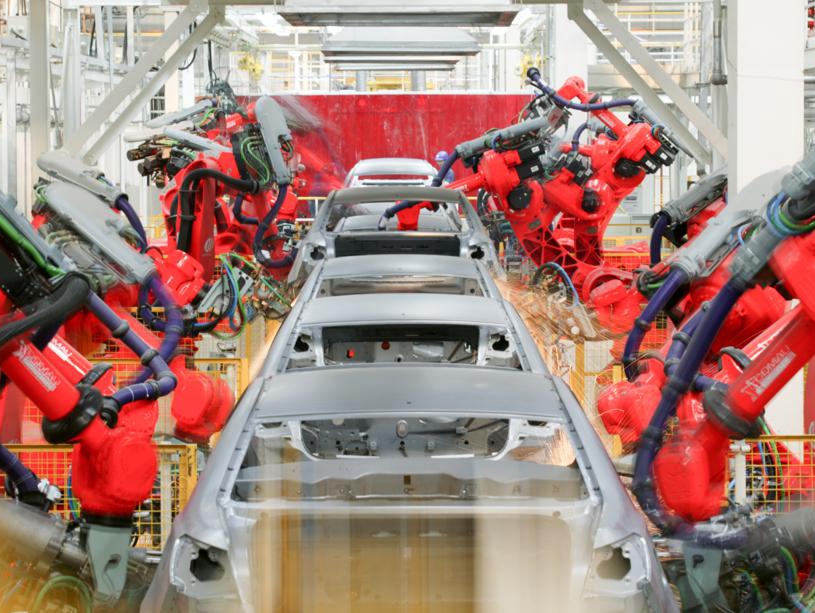Lin-gang Sci-Tech City to provide technologies for four core industries
As a key part of Lin-gang Special Area plans to become an important carrier of Shanghai's functions as an innovation center for science and technology, Lin-gang Sci-Tech City has once again come into people's sights.
In the future, it will be the source of technologies for the core industries in Lin-gang Special Area.
AI, the primary industry to be introduced

Lin-gang Special Area [Photo by Meng Yuhan]
As the Opinions on the Implementation of Preferential Policies to Boost High-quality Development of Lin-gang Special Area of the China (Shanghai) Pilot Free Trade Zone was officially published, policies concerning talents, taxation, industry concentration, transport and infrastructure gave new expectations to Chen Jiong, the board chairman of Shanghai Lingang Technology Innovation City Economic Development Co Ltd.
"Since the establishment of Lin-gang Special Area was announced on Aug 6, 2019 Lingang Sci-Tech City has decided to create the source of technology for core industries in Lin-gang Special Area on the basis of the existing industrial foundation," Chen said. Chen explained that Lingang Sci-Tech City began planning as early as 2015, as a part of Lin-gang's plan to build an important carrier of Shanghai's functions as an innovation center for science and technology. By 2017, Lingang Sci-Tech City had formed a mature plan. Compared with Songjiang Science City, which focuses on fundamental research, Lingang Sci-Tech City focuses on technology transfers based on the industrial features in Lin-gang. Therefore, Lingang Sci-Tech City will continue to focus on the technology transfers of four core industries in the special area: artificial intelligence (AI), integrated circuits (IC), civil aviation and biomedicine.
"Now, AI is the primary industry to be introduced, especially intelligent connected vehicles, industrial internet, chip design and development, and other industries derived from it," Chen said.
According to Chen Jiong said that Lingang Sci-Tech City's existing industrial development mainly depends on the establishment of large basic platforms.
In recent years, Lingang Sci-Tech City has not only worked with China Academy of Information and Communications Technology and other large institutions, but also has attracted and incubated research and development (R&D) companies and projects such as underwater robots through its own marine technology platform.
The establishment of Lin-gang Special Area will further connect the industrial platforms at different levels and in different subsectors in Lin-gang to stimulate more industrial potential.
"Lingang Sci-Tech City already has many research institutes and laboratories," Chen said. "After the establishment of Lin-gang Special Area, Lingang Sci-Tech City is ready to restart, focusing on serving the core industries in Lin-gang Special Area."
According to Chen, Lingang Sci-Tech City will continue to develop marine technology and other industries that have a sound foundation for development. In the future, it will strive for cooperation between its existing industries and the industrial internet, an important part of intelligent manufacturing, to achieve its goal of creating a new source of technology.
Creating ideal test scenarios for automated vehicles
Since its establishment, Lin-gang Special Area's advantage in developing automated vehicle application scenarios has been mentioned many times. In Chen Jiong's view, this advantage is undoubtedly a rare opportunity for Lingang Sci-Tech City.
"Lin-gang is an area with rich scenarios such as a port, a bridge, logistics park, open urban area and the sci-tech city's closed test area. Such 'natural gifts' can greatly enrich the existing automatic driving application scenarios in Shanghai."
Currently, there are more than 130 application scenarios in the closed automated vehicle test area of the sci-tech city alone.
The contract signed with Beijing Institute of Technology, Shanghai Lingang Intelligent Connected Vehicle Research Center and East China Branch of China Academy of Information and Communications Technology shows that the sci-tech city's ambitions in unmanned systems is clearly not limited to land vehicles. It has a broader vision. As early as last May, Lin-gang started construction of China's first Integrated Demonstration Zone for Land, Sea and Air Unmanned Systems, providing a comprehensive supporting environment for AI enterprises. Lin-gang has basically finished construction of the Demonstration Area for Integrated Testing of Intelligent Connected Vehicles. In addition, construction of Dishui Lake Unmanned Boat Demonstration Area, and the Low-altitude Digital Demonstration Area is accelerating.
In the field of automated vehicles, Lin-gang has built 26.1 kilometers of open test roads, 3.2 square kilometers of closed test area and a data center, achieved full coverage of 4G and 5G networks in the area, and built an intelligent transport system environment with vehicle-road coordination. Next, Lin-gang will connect the logistics system of Yangshan Port to explore "sea-road-railway" multimodal transport. At the same time, it will carry out road tests of automated passenger cars based on the passenger flow of Pudong Airport, conduct road tests of automated container trucks based on the logistics in the industrial park, and enrich risk test scenarios based on typical rural roads.
Open test roads in Lin-gang
After planning for 3.2 square kilometers in phase I was approved in 2017, Lingang Sci-Tech City got another opportunity for spatial development last year. In 2018, the First World Laureates Forum was held at Dishui Lake in Lingang. One important achievement was the landing establishment of the WLA Scientific Community.
Chen Jiong said that in the past year, the sci-tech city not only continuously provided a good office and R&D environment for enterprises, but also focused on serving entrepreneurs in their work and lives.
"We are trying to provide the best restaurants, best bookstores and best schools for talents, to keep them in Lin-gang,” Chen said. "We put talents in first place."
The sci-tech city's spatial planning is based on the core area of 3.2 sq km in the first phase, extending to the southwest of Dishui Lake. The overall planned area is 7.8 sq km. High-standard international communities will be built in the area, including international schools, high-end general clinics, and sports and leisure facilities. In addition, the sci-tech city has a running water system from Dishui Lake to the East China Sea. Water sports events such as rowing can be held there.
-
Address No 200 Shengang Avenue, Pudong New Area, Shanghai, China
-
Zip Code 201306
-
TEL +86-21-68283063
-
FAX +86-21-68283000




 In pics: Shanghai Lin-gang youth activity center completed
In pics: Shanghai Lin-gang youth activity center completed
 In pics: Endurance sports enthusiasts gather at Dishui Lake for 2-day event
In pics: Endurance sports enthusiasts gather at Dishui Lake for 2-day event
 Video: SAIC Motor can produce a vehicle every 70 seconds
Video: SAIC Motor can produce a vehicle every 70 seconds


